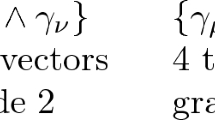Abstract
The global symmetry implied by the fact that one can multiply all masses with a common constant is made into a local, gauge symmetry. The matter action then becomes Conformally invariant and it seems natural to choose for the corresponding scalar gauge field the action for a conformally invariant (massless) scalar field. The resulting conformally invariant theory turns out to be equivalent to general relativity. Since this means that the usual Einstein-Hilbert action is not, in fact, a true gauge action for the space-time geometry, the full theory ought to be supplied with such a term. Gauge-theoretic arguments and conformal invariance requirements dictate its form.
Similar content being viewed by others
References
Birrell, N. D., and Davies, P. C. W. (1982).Quantum Fields in Curved Space, Cambridge University Press, Cambridge.
Harrison, E. R. (1972).Physical Review D,6, 2077.
Penrose, R., and Rindler, W. (1984).Spinors and Space-Time, Vol. 1, Cambridge University Press, Cambridge.
Stelle, K. S. (1978).General Relativity and Gravitation,9, 353.
Wald, R. M. (1984).General Relativity, University of Chicago Press, Chicago, Illinois.
Yang, C. N. (1974).Physical Review Letters,33, 445.
Author information
Authors and Affiliations
Rights and permissions
About this article
Cite this article
Essén, H. General relativity as a conformally invariant scalar gauge field theory. Int J Theor Phys 29, 183–187 (1990). https://doi.org/10.1007/BF00671328
Received:
Issue Date:
DOI: https://doi.org/10.1007/BF00671328




